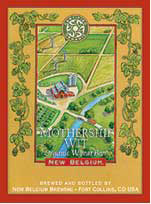 My god, this winter has been so goddamn long that I'm starting to lose it. I feel like I live in Canada, except that I don't have guaranteed health care and I never got good at hockey. It's a good thing that Minnesota has finally started cranking out some decent brews to get us northwoods faithful through.
My god, this winter has been so goddamn long that I'm starting to lose it. I feel like I live in Canada, except that I don't have guaranteed health care and I never got good at hockey. It's a good thing that Minnesota has finally started cranking out some decent brews to get us northwoods faithful through.
Flat Earth Brewery, a new St. Paul brauhaus that I mentioned back here, has been quietly invading bars and liquor stores around the Twin Cities Metro. Last night I had the good fortune to share a few pints with a good friend at the Sample Room, a Northeast Minneapolis institution of which Chef and TV Personality Anthony Bourdain had this to say:
that's another good one. I'm sure his business model wasn't, 'There's a huge demand here for traditionally made pâté, so I'm opening!' It was more like, 'I love pâté, I want to make it old-school, I'm going to create the market and hopefully people will join me.'
Indeed the Sample Room prides itself on its homemade and interesting foodstuffs, and takes equal care to make sure their taps are interesting and fresh. As a local, fresh, and delicious brew, Flat Earth's Belgian Style Pale Ale made the cut.
The beer pours a clear and beautiful amber color with a minimal white head that leaves considerable lacing along the way.
The beer has a faint yeast smell mingling with a sweet fruit aroma. It has a very dynamic nose that refuses to fade as one is drinking the beer.
A medium body ripe with tight bubbles awaits you as you quaff the ale, greeting you with a little yeast up front, some carmelly biscuity malts in the middle, and very subtle finishing hops in the back. The malts will hang on until the finish, but the final taste is quite dry, with notes of grain.
The alcohol is a touch low for the style at 5.2%, but that makes this beer all the more chuggable, with enough flavor to keep you coming back, but not too much as to overwhelm the senses.
Congrats to Flat Earth.
Links of Interest:
Flat Earth





